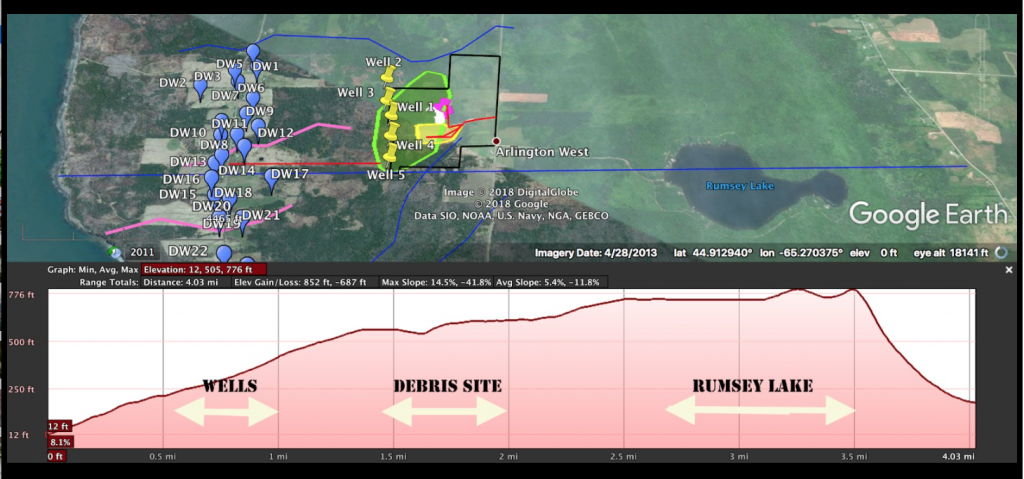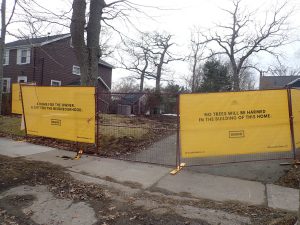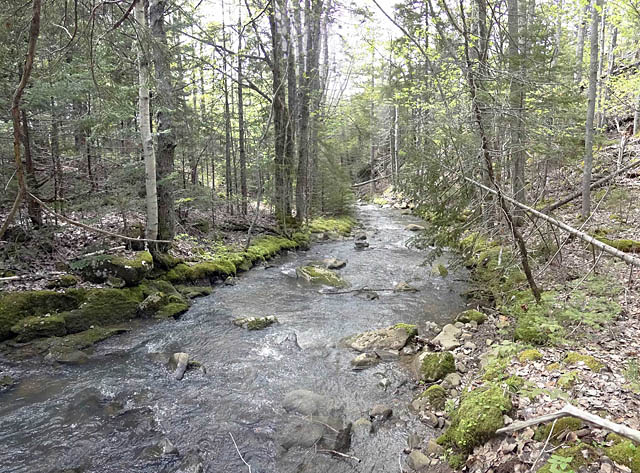Environmental justice embraces the principle that all people and communities are entitled to equal protection of environmental and public health laws and regulations.
— ROBERT D. BULLARD, cited on environmentaljustice.ca
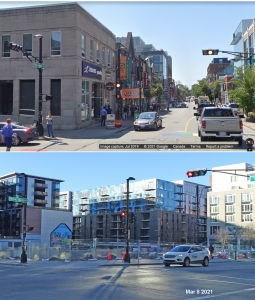
This city block with the once iconic & upscale Mills Brothers (above) disappeared (below) sometime recently. Is its resting place on the North Mountain of the Annapolis Valley?
Tale # 1 has a good if highly protracted ending that we all know about: the closure of Boat Harbour. A good ending justice-wise, that is. Not so good economically in the short term for the forest industry but the government quickly opened our coffers to soften the blow.
A little over a year later and at least some sectors of the forest industry are doing just fine: our sawmills are thriving, an unpredicted outcome of the unpredicted pandemic, and it seems there is no sign of the demand for lumber declining. Many suspect that pressure from the sawmills/WestFor is the reason that L&F/our government chose not to talk to the moose protestors or otherwise strengthen its protection of mainland moose; the government was still smarting from the beating it took from some of its traditional supporters over its stand on Boat Harbour.
Tale # 2 is still in progress and seems to have resided largely below the radar of environmental activists in NS: the disposal of “fluff” and other toxic wastes – mostly from Halifax – at the Arlington dump on the North Mountain overlooking the community of St. Croix Cove.
I learned about it when a post on on Social Media highlighted a new Facebook group, the Annapolis Waterkeepers.
The group, while new on Facebook, has a comprehensive website and has been “fighting the development of a toxic waste dump in our watershed for more than a decade”.
This figure provides a graphic summary of the local issue:
From “About” on www.annapoliswaterkeepers.ca
Waterkeepers
Where is the thatch-roofed village, the home of Acadian farmers,
Men whose lives glided on like rivers that water the woodlands,
Darkened by shadows of earth, but reflecting an image of heaven? – EvangelineThat small village is still here in Annapolis County, Nova Scotia. People have lived here for thousands of years. Europeans for hundreds. We are farmers, fishers, craftspeople and professionals – ordinary folk who have built their homesteads in the pristine and idyllic community of St. Croix Cove. The Bay of Fundy is our front yard; the North Mountain is our back yard.
The mountain provides an abundant supply of clean water. The water is collected by the hand of nature and stored in a large wetland at the source of several brooks. It filters down the mountain through gravel seams and bedrock fissures. We tap dozens of bubbling springs and aquifers with our wells. The trout from the brooks are lean and delicious.
Over the last thirteen years, a construction debris dump found its way into the very top of our watershed. At first we didn’t pay a lot of attention, wishing our neighbor well in his new enterprise and trusting the authorities to look after our best interests. If we received notice or were asked an opinion we can’t remember. We’re certain nothing appeared in our mailboxes. Few of us subscribe to a newspaper, and it’s safe to say no one has ever lingered over the Public Notices.
In 2008 we were still napping when the dump, Arlington heights C&D, applied to become a disposal site for asbestos waste. Disposal of this toxic carcinogen is a big problem for developers, especially in an older city like Halifax. It says a lot that huge trucks make the 325 kilometer round trip to our insignificant community in order to get rid of their burden.
Now Arlington Heights C&D is expanding again, and we are finally waking up. This isn’t simply a case of not-in-my-backyard, but a question of environmental justice and whether people can control their own destiny.
We’ve come to question some of the science that was used to support the location of Arlington Heights C&D. Perhaps more importantly, we’ve come to question the process that brought us to this unhappy situation. We write to our elected representatives, we write to civil servants charged with our health and well-being. It’s like shouting into the storm and we receive no reply.
People may have been around for thousands of years, but Arlington Heights C&D will be around for tens of thousands. We are quite certain that runoff from the site reaches our wells. The procedures that led to a recent underground fire concern us. The release of volumes of smoke and steam are worrisome. Salt water used to extinguish the fire inevitably finds its way to our wetland.
We are calling for a moratorium on the use of Arlington Heights C&D. Let’s hit the pause button, examine the science, redo parts of the Environmental Assessment, hold the trucks in Halifax, and take stock of our own priorities.
Imagine a Nova Scotia where those without a voice are heard. Where people are treated fairly, where decisions are reached on firm evidence and in the full light of day.
That’s the province we hope to live in.
Annapolis Waterkeepers
As a resident of peninsular Halifax, I have been watching a building boom probably unprecedented since the city’s early days. I have actually been pleased to see it as a lot more of the development now taking place in Halifax is ecologically smarter development involving densification in already serviced areas, rather than urban sprawl. That is no accident.
Our HRM Alliance, a coalition business, environmental and community groups, was formed in the early part of the last decade to promote the concept of densification of development in HRM as good for taxes and good for environment; in tandem with the Halifax Green Network Plan it was a concept that was vigorously pursued by HRM when Iain Rankin’s dad was deputy mayor of HRM, and now we seeing the result.
We have learned for sure that one unintended consequence has been a big loss of affordable housing, and that’s getting at least some peoples’ attention.
But few of us, I think, have wondered where all those materials go when we see older houses (some of them not-so old), concrete parking lots and office buildings disappear, literally within a day or two.
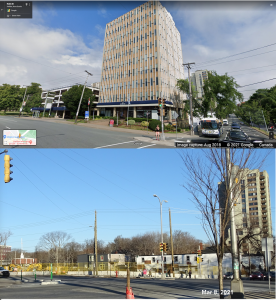
Robie & Quinpool: concrete parking lot & office building just disappeared. Out of Sight, Out of Mind in Halifax but not on the North Mt.
Many of us have probably tacitly assumed that just as HRM has been a leader in composting and recycling (with a good push in that direction in the 1990s from pesky environmentalists), it is taking appropriate care to dispose of such materials without adverse effects on environment or people.
But, apparently, it isn’t.
That’s a provincial issue, an HRM issue and an every-one-of-us issue.
If we have learned anything from Boat Harbour, which carried the additional stress and shame of racism, surely it is that for the sake of both the economy and environmental justice, such issues are best dealt openly and honestly, and sooner rather than later. Much sooner.
Imagine a Nova Scotia where those without a voice are heard. Where people are treated fairly, where decisions are reached on firm evidence and in the full light of day.
Indeed.
“Nova Scotians place a high value on our province’s natural environment,” Mr. Rankin said. “I was pleased to be a part of a government that in 2020 acted to address the legacy of environmental racism at Boat Harbour and want to ensure that no community in Nova Scotia is ever similarly affected again.”
‘Want to comment on this post? Please comment on NSFN content via WWNS; MP usually makes a post on WWNS about my posts; if not, you can simply reference the content or URL* on NSFN in a post on WWNS. *For this post, the URL is http://nsforestnotes.ca/2021/03/14/two-tales-of-environmental-justice-versus-the-economy-in-nova-scotia-14mar2021/
Some Links
Environment Department investigating Annapolis County business
Michael Gorman · CBC News · Posted: Feb 01
Weekend video: Poisoned village
On Halifax Examiner Feb 5, 2021

From discussion on Annapolis Royal and Area – Environment and Ecology Mar 15, 2021
Chronicle Herald Mar 11, 2021. Subscription required. Image on wwns “The choice is not either/or. We can have environment, economy and equity. In fact, we must have all three.”
Shades of Green
Exploring Environmental Justice in Unceded Mi’kma’ki
The ENRICH Project
The ENRICH Project is a collaborative community-based project investigating the cause and effects of toxic industries situated near Mi’kmaq and African Nova Scotian communities.
There’s something in the water, and not just in Nova Scotia – Addressing environmental racism Canada-wide
Robert Devet in the Nova Scotia Advocate Dec 1, 2020
Joan Kuyek: Our job is to take our governments back from the mining interests
Joan Baxter in the Halifax Examiner, oct 16, 2019.
Nova Scotia MP’s bill targets environmental racism
Andrea Gunn in the Chronicle Herald feb 28, 2020

